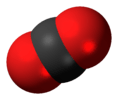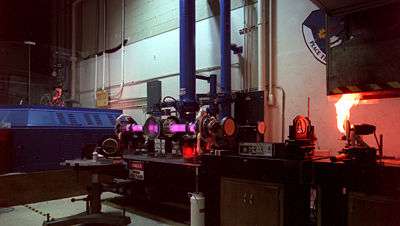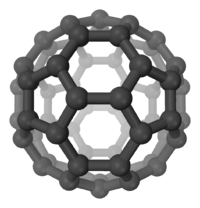Carbon dioxide
Carbon dioxide (chemical formula CO
2) is a colorless gas with a density about 60% higher than that of dry air. Carbon dioxide consists of a carbon atom covalently double bonded to two oxygen atoms. It occurs naturally in Earth's atmosphere as a trace gas. The current concentration is about 0.04% (412 ppm) by volume, having risen from pre-industrial levels of 280 ppm.[8] Natural sources include volcanoes, hot springs and geysers, and it is freed from carbonate rocks by dissolution in water and acids. Because carbon dioxide is soluble in water, it occurs naturally in groundwater, rivers and lakes, ice caps, glaciers and seawater. It is present in deposits of petroleum and natural gas. Carbon dioxide is odorless at normally encountered concentrations, but at high concentrations, it has a sharp and acidic odor.[1] At such concentrations it generates the taste of soda water in the mouth.[9]
 | |||
| |||
| Names | |||
|---|---|---|---|
Other names
| |||
| Identifiers | |||
3D model (JSmol) |
|||
| 3DMet | |||
| 1900390 | |||
| ChEBI | |||
| ChEMBL | |||
| ChemSpider | |||
| ECHA InfoCard | 100.004.271 | ||
| EC Number |
| ||
| E number | E290 (preservatives) | ||
| 989 | |||
| KEGG | |||
| MeSH | Carbon+dioxide | ||
PubChem CID |
|||
| RTECS number |
| ||
| UNII | |||
| UN number | 1013 (gas), 1845 (solid) | ||
CompTox Dashboard (EPA) |
|||
| |||
| |||
| Properties | |||
| CO2 | |||
| Molar mass | 44.009 g·mol−1 | ||
| Appearance | Colorless gas | ||
| Odor |
| ||
| Density |
| ||
| Melting point | −56.6 °C; −69.8 °F; 216.6 K (triple point at 5.1 atm) | ||
| Critical point (T, P) | 31.1 °C (304.2 K), 7.38 megapascals (73.8 bar) | ||
| −78.5 °C; −109.2 °F; 194.7 K (1 atm) | |||
| 1.45 g/L at 25 °C (77 °F), 100 kPa | |||
| Vapor pressure | 5.73 MPa (20 °C) | ||
| Acidity (pKa) | 6.35, 10.33 | ||
| −20.5·10−6 cm3/mol | |||
| Thermal conductivity | 0.01662 W·m−1·K−1 (300 K)[2] | ||
Refractive index (nD) |
1.00045 | ||
| Viscosity |
| ||
| 0 D | |||
| Structure | |||
| Trigonal | |||
| Linear | |||
| Thermochemistry | |||
Heat capacity (C) |
37.135 J/K·mol | ||
Std molar entropy (S |
214 J·mol−1·K−1 | ||
Std enthalpy of formation (ΔfH⦵298) |
−393.5 kJ·mol−1 | ||
| Pharmacology | |||
| V03AN02 (WHO) | |||
| Hazards | |||
| Safety data sheet | See: data page Sigma-Aldrich | ||
| NFPA 704 (fire diamond) | |||
| Lethal dose or concentration (LD, LC): | |||
LCLo (lowest published) |
90,000 ppm (human, 5 min)[6] | ||
| NIOSH (US health exposure limits): | |||
PEL (Permissible) |
TWA 5000 ppm (9000 mg/m3)[7] | ||
REL (Recommended) |
TWA 5000 ppm (9000 mg/m3), ST 30,000 ppm (54,000 mg/m3)[7] | ||
IDLH (Immediate danger) |
40,000 ppm[7] | ||
| Related compounds | |||
Other anions |
| ||
Other cations |
| ||
Related compounds |
|||
| Supplementary data page | |||
| Refractive index (n), Dielectric constant (εr), etc. | |||
Thermodynamic data |
Phase behaviour solid–liquid–gas | ||
| UV, IR, NMR, MS | |||
Except where otherwise noted, data are given for materials in their standard state (at 25 °C [77 °F], 100 kPa). | |||
| Infobox references | |||
As the source of available carbon in the carbon cycle, atmospheric carbon dioxide is the primary carbon source for life on Earth and its concentration in Earth's pre-industrial atmosphere since late in the Precambrian has been regulated by photosynthetic organisms and geological phenomena. Plants, algae and cyanobacteria use light energy to photosynthesize carbohydrate from carbon dioxide and water, with oxygen produced as a waste product.[10]
CO
2 is produced by all aerobic organisms when they metabolize carbohydrates and lipids to produce energy by respiration.[11] It is returned to water via the gills of fish and to the air via the lungs of air-breathing land animals, including humans. Carbon dioxide is produced during the processes of decay of organic materials and the fermentation of sugars in bread, beer and wine making. It is produced by combustion of wood and other organic materials and fossil fuels such as coal, peat, petroleum and natural gas. It is an unwanted byproduct in many large scale oxidation processes, for example, in the production of acrylic acid (over 5 million tons/year).[12][13][14]
It is a versatile industrial material, used, for example, as an inert gas in welding and fire extinguishers, as a pressurizing gas in air guns and oil recovery, as a chemical feedstock and as a supercritical fluid solvent in decaffeination of coffee and supercritical drying.[15] It is added to drinking water and carbonated beverages including beer and sparkling wine to add effervescence. The frozen solid form of CO
2, known as dry ice is used as a refrigerant and as an abrasive in dry-ice blasting. It is a feedstock for the synthesis of fuels and chemicals.[16][17][18][19]
Carbon dioxide is the most significant long-lived greenhouse gas in Earth's atmosphere. Since the Industrial Revolution anthropogenic emissions – primarily from use of fossil fuels and deforestation – have rapidly increased its concentration in the atmosphere, leading to global warming. Carbon dioxide also causes ocean acidification because it dissolves in water to form carbonic acid.[20]
Background
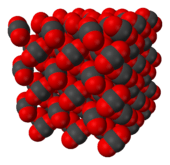
Carbon dioxide was the first gas to be described as a discrete substance. In about 1640,[21] the Flemish chemist Jan Baptist van Helmont observed that when he burned charcoal in a closed vessel, the mass of the resulting ash was much less than that of the original charcoal. His interpretation was that the rest of the charcoal had been transmuted into an invisible substance he termed a "gas" or "wild spirit" (spiritus sylvestris).[22]
The properties of carbon dioxide were further studied in the 1750s by the Scottish physician Joseph Black. He found that limestone (calcium carbonate) could be heated or treated with acids to yield a gas he called "fixed air." He observed that the fixed air was denser than air and supported neither flame nor animal life. Black also found that when bubbled through limewater (a saturated aqueous solution of calcium hydroxide), it would precipitate calcium carbonate. He used this phenomenon to illustrate that carbon dioxide is produced by animal respiration and microbial fermentation. In 1772, English chemist Joseph Priestley published a paper entitled Impregnating Water with Fixed Air in which he described a process of dripping sulfuric acid (or oil of vitriol as Priestley knew it) on chalk in order to produce carbon dioxide, and forcing the gas to dissolve by agitating a bowl of water in contact with the gas.[23]
Carbon dioxide was first liquefied (at elevated pressures) in 1823 by Humphry Davy and Michael Faraday.[24] The earliest description of solid carbon dioxide (dry ice) was given by the French inventor Adrien-Jean-Pierre Thilorier, who in 1835 opened a pressurized container of liquid carbon dioxide, only to find that the cooling produced by the rapid evaporation of the liquid yielded a "snow" of solid CO
2.[25][26]
Chemical and physical properties
Structure and bonding
The carbon dioxide molecule is linear and centrosymmetric at equilibrium. The carbon–oxygen bond length is 116.3 pm, noticeably shorter than the bond length of a C–O single bond and even shorter than most other C–O multiply-bonded functional groups.[27] Since it is centrosymmetric, the molecule has no electrical dipole.

2 carbon dioxide molecule. Upper left: symmetric stretching. Upper right: antisymmetric stretching. Lower line: degenerate pair of bending modes.
As a linear triatomic molecule, CO2 has four vibrational modes as shown in the diagram. However, the symmetric stretching mode does not create a dipole and so is not observed in the IR spectrum. The two bending modes are degenerate, meaning that they correspond to only one frequency. Consequently, only two vibrational bands are observed in the IR spectrum – an antisymmetric stretching mode at wavenumber 2349 cm−1 and a degenerate pair of bending modes at 667 cm−1 (wavelength 15 μm). There is also a symmetric stretching mode at 1388 cm−1 which is only observed in the Raman spectrum.[28]
As a result of the two bending modes, the molecule is only strictly linear when the amount of bending is zero. It has been shown both by theory[29] and by Coulomb explosion imaging experiments.[30] that this is never actually true for both modes at once. In a gas phase sample of carbon dioxide, none of the molecules are linear as a result of the vibrational motions. However, the molecular geometry is still described as linear, which describes the average atomic positions corresponding to minimum potential energy. This is also true for other “linear” molecules.
In aqueous solution
Carbon dioxide is soluble in water, in which it reversibly forms H
2CO
3 (carbonic acid), which is a weak acid since its ionization in water is incomplete.
- CO
2 + H
2O ⇌ H
2CO
3
The hydration equilibrium constant of carbonic acid is (at 25 °C). Hence, the majority of the carbon dioxide is not converted into carbonic acid, but remains as CO
2 molecules, not affecting the pH.
The relative concentrations of CO
2, H
2CO
3, and the deprotonated forms HCO−
3 (bicarbonate) and CO2−
3(carbonate) depend on the pH. As shown in a Bjerrum plot, in neutral or slightly alkaline water (pH > 6.5), the bicarbonate form predominates (>50%) becoming the most prevalent (>95%) at the pH of seawater. In very alkaline water (pH > 10.4), the predominant (>50%) form is carbonate. The oceans, being mildly alkaline with typical pH = 8.2–8.5, contain about 120 mg of bicarbonate per liter.
Being diprotic, carbonic acid has two acid dissociation constants, the first one for the dissociation into the bicarbonate (also called hydrogen carbonate) ion (HCO3−):
- H2CO3 ⇌ HCO3− + H+
- Ka1 = 2.5×10−4 mol/L; pKa1 = 3.6 at 25 °C.[27]
This is the true first acid dissociation constant, defined as , where the denominator includes only covalently bound H2CO3 and does not include hydrated CO
2(aq). The much smaller and often-quoted value near 4.16×10−7 is an apparent value calculated on the (incorrect) assumption that all dissolved CO
2 is present as carbonic acid, so that . Since most of the dissolved CO
2 remains as CO
2 molecules, Ka1(apparent) has a much larger denominator and a much smaller value than the true Ka1.[31]
The bicarbonate ion is an amphoteric species that can act as an acid or as a base, depending on pH of the solution. At high pH, it dissociates significantly into the carbonate ion (CO32−):
- HCO3− ⇌ CO32− + H+
- Ka2 = 4.69×10−11 mol/L; pKa2 = 10.329
In organisms carbonic acid production is catalysed by the enzyme, carbonic anhydrase.
Chemical reactions of CO2
CO
2 is a potent electrophile having an electrophilic reactivity that is comparable to benzaldehyde or strong α,β-unsaturated carbonyl compounds. However, unlike electrophiles of similar reactivity, the reactions of nucleophiles with CO
2 are thermodynamically less favored and are often found to be highly reversible.[32] Only very strong nucleophiles, like the carbanions provided by Grignard reagents and organolithium compounds react with CO
2 to give carboxylates:
In metal carbon dioxide complexes, CO
2 serves as a ligand, which can facilitate the conversion of CO
2 to other chemicals.[33]
The reduction of CO
2 to CO is ordinarily a difficult and slow reaction:
- CO
2 + 2 e− + 2H+ → CO + H2O
Photoautotrophs (i.e. plants and cyanobacteria) use the energy contained in sunlight to photosynthesize simple sugars from CO
2 absorbed from the air and water:
- n CO
2 + n H
2O → (CH
2O)
n + n O
2
The redox potential for this reaction near pH 7 is about −0.53 V versus the standard hydrogen electrode. The nickel-containing enzyme carbon monoxide dehydrogenase catalyses this process.[34]
Physical properties
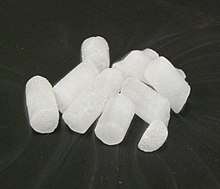
Carbon dioxide is colorless. At low concentrations the gas is odorless; however, at sufficiently-high concentrations, it has a sharp, acidic odor.[1] At standard temperature and pressure, the density of carbon dioxide is around 1.98 kg/m3, about 1.67 times that of air.
Carbon dioxide has no liquid state at pressures below 5.1 standard atmospheres (520 kPa). At 1 atmosphere (near mean sea level pressure), the gas deposits directly to a solid at temperatures below −78.5 °C (−109.3 °F; 194.7 K) and the solid sublimes directly to a gas above −78.5 °C. In its solid state, carbon dioxide is commonly called dry ice.
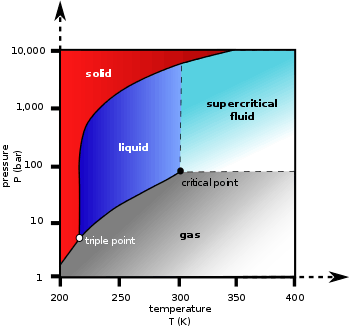
Liquid carbon dioxide forms only at pressures above 5.1 atm; the triple point of carbon dioxide is about 5.1 bar (517 kPa) at 217 K (see phase diagram). The critical point is 7.38 MPa at 31.1 °C.[35][36] Another form of solid carbon dioxide observed at high pressure is an amorphous glass-like solid.[37] This form of glass, called carbonia, is produced by supercooling heated CO
2 at extreme pressure (40–48 GPa or about 400,000 atmospheres) in a diamond anvil. This discovery confirmed the theory that carbon dioxide could exist in a glass state similar to other members of its elemental family, like silicon (silica glass) and germanium dioxide. Unlike silica and germania glasses, however, carbonia glass is not stable at normal pressures and reverts to gas when pressure is released.
At temperatures and pressures above the critical point, carbon dioxide behaves as a supercritical fluid known as supercritical carbon dioxide. In this state it is starting (as of 2018) to be used for power generation.[38]
Isolation and production
Carbon dioxide can be obtained by distillation from air, but the method is inefficient. Industrially, carbon dioxide is predominantly an unrecovered waste product, produced by several methods which may be practiced at various scales.[39]
The combustion of all carbon-based fuels, such as methane (natural gas), petroleum distillates (gasoline, diesel, kerosene, propane), coal, wood and generic organic matter produces carbon dioxide and, except in the case of pure carbon, water. As an example, the chemical reaction between methane and oxygen:
- CH
4 + 2 O
2 → CO
2 + 2 H
2O
It is produced by thermal decomposition of limestone, CaCO
3 by heating (calcining) at about 850 °C (1,560 °F), in the manufacture of quicklime (calcium oxide, CaO), a compound that has many industrial uses:
- CaCO
3 → CaO + CO
2
Iron is reduced from its oxides with coke in a blast furnace, producing pig iron and carbon dioxide:[40]
Carbon dioxide is a byproduct of the industrial production of hydrogen by steam reforming and the water gas shift reaction in ammonia production. These processes begin with the reaction of water and natural gas (mainly methane).[41] This is a major source of food-grade carbon dioxide for use in carbonation of beer and soft drinks, and is also used for stunning animals such as poultry. In the summer of 2018 a shortage of carbon dioxide for these purposes arose in Europe due to the temporary shut-down of several ammonia plants for maintenance.[42]
Acids liberate CO
2 from most metal carbonates. Consequently, it may be obtained directly from natural carbon dioxide springs, where it is produced by the action of acidified water on limestone or dolomite. The reaction between hydrochloric acid and calcium carbonate (limestone or chalk) is shown below:
- CaCO
3 + 2 HCl → CaCl
2 + H
2CO
3
The carbonic acid (H
2CO
3) then decomposes to water and CO
2:
- H
2CO
3 → CO
2 + H
2O
Such reactions are accompanied by foaming or bubbling, or both, as the gas is released. They have widespread uses in industry because they can be used to neutralize waste acid streams.
Carbon dioxide is a by-product of the fermentation of sugar in the brewing of beer, whisky and other alcoholic beverages and in the production of bioethanol. Yeast metabolizes sugar to produce CO
2 and ethanol, also known as alcohol, as follows:
- C
6H
12O
6 → 2 CO
2 + 2 C
2H
5OH
All aerobic organisms produce CO
2 when they oxidize carbohydrates, fatty acids, and proteins. The large number of reactions involved are exceedingly complex and not described easily. Refer to (cellular respiration, anaerobic respiration and photosynthesis). The equation for the respiration of glucose and other monosaccharides is:
- C
6H
12O
6 + 6 O
2 → 6 CO
2 + 6 H
2O
Anaerobic organisms decompose organic material producing methane and carbon dioxide together with traces of other compounds.[43] Regardless of the type of organic material, the production of gases follows well defined kinetic pattern. Carbon dioxide comprises about 40–45% of the gas that emanates from decomposition in landfills (termed "landfill gas"). Most of the remaining 50–55% is methane.[44]
Applications
Carbon dioxide is used by the food industry, the oil industry, and the chemical industry.[39] The compound has varied commercial uses but one of its greatest uses as a chemical is in the production of carbonated beverages; it provides the sparkle in carbonated beverages such as soda water, beer and sparkling wine.
Precursor to chemicals
In the chemical industry, carbon dioxide is mainly consumed as an ingredient in the production of urea, with a smaller fraction being used to produce methanol and a range of other products.[45] Some carboxylic acid derivatives such as sodium salicylate are prepared using CO
2 by the Kolbe-Schmitt reaction.[46]
In addition to conventional processes using CO
2 for chemical production, electrochemical methods are also being explored at a research level. In particular, the use of renewable energy for production of fuels from CO
2 (such as methanol) is attractive as this could result in fuels that could be easily transported and used within conventional combustion technologies but have no net CO
2 emissions.[47]
Foods
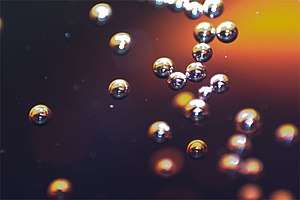
Carbon dioxide is a food additive used as a propellant and acidity regulator in the food industry. It is approved for usage in the EU[48] (listed as E number E290), US[49] and Australia and New Zealand[50] (listed by its INS number 290).
A candy called Pop Rocks is pressurized with carbon dioxide gas[51] at about 4 × 106 Pa (40 bar, 580 psi). When placed in the mouth, it dissolves (just like other hard candy) and releases the gas bubbles with an audible pop.
Leavening agents cause dough to rise by producing carbon dioxide.[52] Baker's yeast produces carbon dioxide by fermentation of sugars within the dough, while chemical leaveners such as baking powder and baking soda release carbon dioxide when heated or if exposed to acids.
Beverages
Carbon dioxide is used to produce carbonated soft drinks and soda water. Traditionally, the carbonation of beer and sparkling wine came about through natural fermentation, but many manufacturers carbonate these drinks with carbon dioxide recovered from the fermentation process. In the case of bottled and kegged beer, the most common method used is carbonation with recycled carbon dioxide. With the exception of British real ale, draught beer is usually transferred from kegs in a cold room or cellar to dispensing taps on the bar using pressurized carbon dioxide, sometimes mixed with nitrogen.
The taste of soda water (and related taste sensations in other carbonated beverages) is an effect of the dissolved carbon dioxide rather than the bursting bubbles of the gas. Carbonic anhydrase 4 converts to carbonic acid leading to a sour taste, and also the dissolved carbon dioxide induces a somatosensory response.[53]
Winemaking
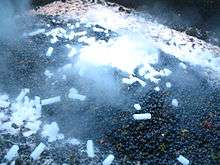
Carbon dioxide in the form of dry ice is often used during the cold soak phase in winemaking to cool clusters of grapes quickly after picking to help prevent spontaneous fermentation by wild yeast. The main advantage of using dry ice over water ice is that it cools the grapes without adding any additional water that might decrease the sugar concentration in the grape must, and thus the alcohol concentration in the finished wine. Carbon dioxide is also used to create a hypoxic environment for carbonic maceration, the process used to produce Beaujolais wine.
Carbon dioxide is sometimes used to top up wine bottles or other storage vessels such as barrels to prevent oxidation, though it has the problem that it can dissolve into the wine, making a previously still wine slightly fizzy. For this reason, other gases such as nitrogen or argon are preferred for this process by professional wine makers.
Stunning animals
Carbon dioxide is often used to "stun" animals before slaughter.[54] "Stunning" may be a misnomer, as the animals are not knocked out immediately and may suffer distress.[55][56]
Inert gas
It is one of the most commonly used compressed gases for pneumatic (pressurized gas) systems in portable pressure tools. Carbon dioxide is also used as an atmosphere for welding, although in the welding arc, it reacts to oxidize most metals. Use in the automotive industry is common despite significant evidence that welds made in carbon dioxide are more brittle than those made in more inert atmospheres. It is used as a welding gas primarily because it is much less expensive than more inert gases such as argon or helium. When used for MIG welding, CO
2 use is sometimes referred to as MAG welding, for Metal Active Gas, as CO
2 can react at these high temperatures. It tends to produce a hotter puddle than truly inert atmospheres, improving the flow characteristics. Although, this may be due to atmospheric reactions occurring at the puddle site. This is usually the opposite of the desired effect when welding, as it tends to embrittle the site, but may not be a problem for general mild steel welding, where ultimate ductility is not a major concern.
It is used in many consumer products that require pressurized gas because it is inexpensive and nonflammable, and because it undergoes a phase transition from gas to liquid at room temperature at an attainable pressure of approximately 60 bar (870 psi, 59 atm), allowing far more carbon dioxide to fit in a given container than otherwise would. Life jackets often contain canisters of pressured carbon dioxide for quick inflation. Aluminium capsules of CO
2 are also sold as supplies of compressed gas for air guns, paintball markers/guns, inflating bicycle tires, and for making carbonated water. Rapid vaporization of liquid carbon dioxide is used for blasting in coal mines. High concentrations of carbon dioxide can also be used to kill pests. Liquid carbon dioxide is used in supercritical drying of some food products and technological materials, in the preparation of specimens for scanning electron microscopy[57] and in the decaffeination of coffee beans.
Fire extinguisher

2 fire extinguisher.
Carbon dioxide can be used to extinguish flames by flooding the environment around the flame with the gas. It does not itself react to extinguish the flame, but starves the flame of oxygen by displacing it. Some fire extinguishers, especially those designed for electrical fires, contain liquid carbon dioxide under pressure. Carbon dioxide extinguishers work well on small flammable liquid and electrical fires, but not on ordinary combustible fires, because although it excludes oxygen, it does not cool the burning substances significantly and when the carbon dioxide disperses they are free to catch fire upon exposure to atmospheric oxygen. Their desirability in electrical fire stems from the fact that, unlike water or other chemical based methods, Carbon dioxide will not cause short circuits, leading to even more damage to equipment. Because it is a gas, it is also easy to dispense large amounts of the gas automatically in IT infrastructure rooms, where the fire itself might be hard to reach with more immediate methods because it is behind rack doors and inside of cases. Carbon dioxide has also been widely used as an extinguishing agent in fixed fire protection systems for local application of specific hazards and total flooding of a protected space.[58] International Maritime Organization standards also recognize carbon dioxide systems for fire protection of ship holds and engine rooms. Carbon dioxide based fire protection systems have been linked to several deaths, because it can cause suffocation in sufficiently high concentrations. A review of CO
2 systems identified 51 incidents between 1975 and the date of the report (2000), causing 72 deaths and 145 injuries.[59]
Supercritical CO2 as solvent
Liquid carbon dioxide is a good solvent for many lipophilic organic compounds and is used to remove caffeine from coffee.[15] Carbon dioxide has attracted attention in the pharmaceutical and other chemical processing industries as a less toxic alternative to more traditional solvents such as organochlorides. It is also used by some dry cleaners for this reason (see green chemistry). It is used in the preparation of some aerogels because of the properties of supercritical carbon dioxide.
Agriculture
Plants require carbon dioxide to conduct photosynthesis. The atmospheres of greenhouses may (if of large size, must) be enriched with additional CO
2 to sustain and increase the rate of plant growth.[60][61] At very high concentrations (100 times atmospheric concentration, or greater), carbon dioxide can be toxic to animal life, so raising the concentration to 10,000 ppm (1%) or higher for several hours will eliminate pests such as whiteflies and spider mites in a greenhouse.[62]
Medical and pharmacological uses
In medicine, up to 5% carbon dioxide (130 times atmospheric concentration) is added to oxygen for stimulation of breathing after apnea and to stabilize the O
2/CO
2 balance in blood.
Carbon dioxide can be mixed with up to 50% oxygen, forming an inhalable gas; this is known as Carbogen and has a variety of medical and research uses.
Energy
Fossil fuel recovery
Carbon dioxide is used in enhanced oil recovery where it is injected into or adjacent to producing oil wells, usually under supercritical conditions, when it becomes miscible with the oil. This approach can increase original oil recovery by reducing residual oil saturation by between 7% to 23% additional to primary extraction.[63] It acts as both a pressurizing agent and, when dissolved into the underground crude oil, significantly reduces its viscosity, and changing surface chemistry enabling the oil to flow more rapidly through the reservoir to the removal well.[64] In mature oil fields, extensive pipe networks are used to carry the carbon dioxide to the injection points.
In enhanced coal bed methane recovery, carbon dioxide would be pumped into the coal seam to displace methane, as opposed to current methods which primarily rely on the removal of water (to reduce pressure) to make the coal seam release its trapped methane.[65]
Bio transformation into fuel
It has been proposed that CO
2 from power generation be bubbled into ponds to stimulate growth of algae that could then be converted into biodiesel fuel.[66] A strain of the cyanobacterium Synechococcus elongatus has been genetically engineered to produce the fuels isobutyraldehyde and isobutanol from CO
2 using photosynthesis.[67]
Refrigerant
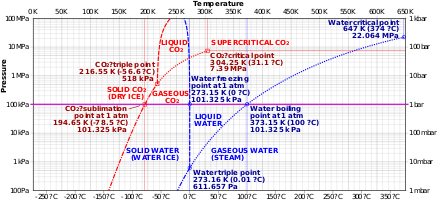
Liquid and solid carbon dioxide are important refrigerants, especially in the food industry, where they are employed during the transportation and storage of ice cream and other frozen foods. Solid carbon dioxide is called "dry ice" and is used for small shipments where refrigeration equipment is not practical. Solid carbon dioxide is always below −78.5 °C (−109.3 °F) at regular atmospheric pressure, regardless of the air temperature.
Liquid carbon dioxide (industry nomenclature R744 or R-744) was used as a refrigerant prior to the discovery of R-12 and may enjoy a renaissance due to the fact that R134a contributes to climate change more than CO
2 does. Its physical properties are highly favorable for cooling, refrigeration, and heating purposes, having a high volumetric cooling capacity. Due to the need to operate at pressures of up to 130 bar (1880 psi), CO
2 systems require highly resistant components that have already been developed for mass production in many sectors. In automobile air conditioning, in more than 90% of all driving conditions for latitudes higher than 50°, R744 operates more efficiently than systems using R134a. Its environmental advantages (GWP of 1, non-ozone depleting, non-toxic, non-flammable) could make it the future working fluid to replace current HFCs in cars, supermarkets, and heat pump water heaters, among others. Coca-Cola has fielded CO
2-based beverage coolers and the U.S. Army is interested in CO
2 refrigeration and heating technology.[68][69]
The global automobile industry is expected to decide on the next-generation refrigerant in car air conditioning. CO
2 is one discussed option.(see Sustainable automotive air conditioning)
Minor uses
Carbon dioxide is the lasing medium in a carbon dioxide laser, which is one of the earliest type of lasers.
Carbon dioxide can be used as a means of controlling the pH of swimming pools,[70] by continuously adding gas to the water, thus keeping the pH from rising. Among the advantages of this is the avoidance of handling (more hazardous) acids. Similarly, it is also used in the maintaining reef aquaria, where it is commonly used in calcium reactors to temporarily lower the pH of water being passed over calcium carbonate in order to allow the calcium carbonate to dissolve into the water more freely where it is used by some corals to build their skeleton.
Used as the primary coolant in the British advanced gas-cooled reactor for nuclear power generation.
Carbon dioxide induction is commonly used for the euthanasia of laboratory research animals. Methods to administer CO
2 include placing animals directly into a closed, prefilled chamber containing CO
2, or exposure to a gradually increasing concentration of CO
2. In 2013, the American Veterinary Medical Association issued new guidelines for carbon dioxide induction, stating that a displacement rate of 10% to 30% of the gas chamber volume per minute is optimal for the humane euthanization of small rodents.[71] However, there is opposition to the practice of using carbon dioxide for this, on the grounds that it is cruel.[56]
Carbon dioxide is also used in several related cleaning and surface preparation techniques.
In Earth's atmosphere
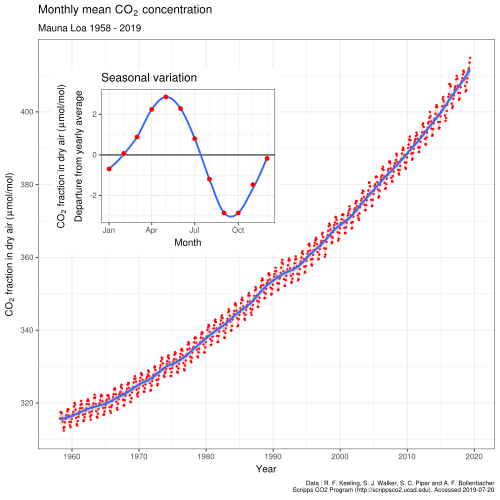
Carbon dioxide in Earth's atmosphere is a trace gas, currently (start of 2020) having a global average concentration of 412 parts per million by volume[72][73][74] (or 622 parts per million by mass). Atmospheric concentrations of carbon dioxide fluctuate slightly with the seasons, falling during the Northern Hemisphere spring and summer as plants consume the gas and rising during northern autumn and winter as plants go dormant or die and decay. Concentrations also vary on a regional basis, most strongly near the ground with much smaller variations aloft. In urban areas concentrations are generally higher[75] and indoors they can reach 10 times background levels.
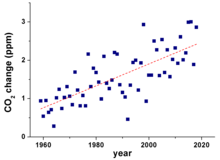
2: In the 1960s, the average annual increase was 35% of the 2009-2018 average.[76]
The concentration of carbon dioxide has risen due to human activities.[77] Combustion of fossil fuels and deforestation have caused the atmospheric concentration of carbon dioxide to increase by about 43% since the beginning of the age of industrialization.[78] Most carbon dioxide from human activities is released from burning coal and other fossil fuels. Other human activities, including deforestation, biomass burning, and cement production also produce carbon dioxide. Human activities emit about 29 billion tons of carbon dioxide per year, while volcanoes emit between 0.2 and 0.3 billion tons.[79][80] Human activities have caused CO
2 to increase above levels not seen in hundreds of thousands of years. Currently, about half of the carbon dioxide released from the burning of fossil fuels remains in the atmosphere and is not absorbed by vegetation and the oceans.[81][82][83][84]
While transparent to visible light, carbon dioxide is a greenhouse gas, absorbing and emitting infrared radiation at its two infrared-active vibrational frequencies (see the section "Structure and bonding" above). Light emission from the earth's surface is most intense in the infrared region between 200 and 2500 cm−1,[85] as opposed to light emission from the much hotter sun which is most intense in the visible region. Absorption of infrared light at the vibrational frequencies of atmospheric carbon dioxide traps energy near the surface, warming the surface and the lower atmosphere. Less energy reaches the upper atmosphere, which is therefore cooler because of this absorption.[86] Increases in atmospheric concentrations of CO
2 and other long-lived greenhouse gases such as methane, nitrous oxide and ozone have correspondingly strengthened their absorption and emission of infrared radiation, causing the rise in average global temperature since the mid-20th century. Carbon dioxide is of greatest concern because it exerts a larger overall warming influence than all of these other gases combined and because it has a long atmospheric lifetime (hundreds to thousands of years).
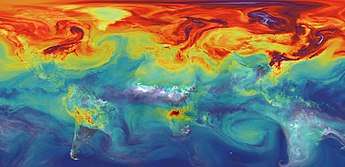
2 in Earth's atmosphere if half of global-warming emissions are not absorbed.[81][82][83][84]
(NASA computer simulation).
Not only do increasing carbon dioxide concentrations lead to increases in global surface temperature, but increasing global temperatures also cause increasing concentrations of carbon dioxide. This produces a positive feedback for changes induced by other processes such as orbital cycles.[87] Five hundred million years ago the carbon dioxide concentration was 20 times greater than today, decreasing to 4–5 times during the Jurassic period and then slowly declining with a particularly swift reduction occurring 49 million years ago.[88][89]
Local concentrations of carbon dioxide can reach high values near strong sources, especially those that are isolated by surrounding terrain. At the Bossoleto hot spring near Rapolano Terme in Tuscany, Italy, situated in a bowl-shaped depression about 100 m (330 ft) in diameter, concentrations of CO
2 rise to above 75% overnight, sufficient to kill insects and small animals. After sunrise the gas is dispersed by convection.[90] High concentrations of CO
2 produced by disturbance of deep lake water saturated with CO
2 are thought to have caused 37 fatalities at Lake Monoun, Cameroon in 1984 and 1700 casualties at Lake Nyos, Cameroon in 1986.[91]
In the oceans
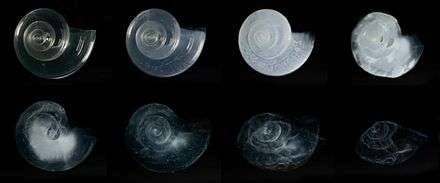
Carbon dioxide dissolves in the ocean to form carbonic acid (H2CO3), bicarbonate (HCO3−) and carbonate (CO32−). There is about fifty times as much carbon dioxide dissolved in the oceans as exists in the atmosphere. The oceans act as an enormous carbon sink, and have taken up about a third of CO
2 emitted by human activity.[92]
As the concentration of carbon dioxide increases in the atmosphere, the increased uptake of carbon dioxide into the oceans is causing a measurable decrease in the pH of the oceans, which is referred to as ocean acidification. This reduction in pH affects biological systems in the oceans, primarily oceanic calcifying organisms. These effects span the food chain from autotrophs to heterotrophs and include organisms such as coccolithophores, corals, foraminifera, echinoderms, crustaceans and mollusks. Under normal conditions, calcium carbonate is stable in surface waters since the carbonate ion is at supersaturating concentrations. However, as ocean pH falls, so does the concentration of this ion, and when carbonate becomes undersaturated, structures made of calcium carbonate are vulnerable to dissolution.[93] Corals,[94][95][96] coccolithophore algae,[97][98][99][100] coralline algae,[101] foraminifera,[102] shellfish[103] and pteropods[104] experience reduced calcification or enhanced dissolution when exposed to elevated CO
2.
Gas solubility decreases as the temperature of water increases (except when both pressure exceeds 300 bar and temperature exceeds 393 K, only found near deep geothermal vents)[105] and therefore the rate of uptake from the atmosphere decreases as ocean temperatures rise.
Most of the CO
2 taken up by the ocean, which is about 30% of the total released into the atmosphere,[106] forms carbonic acid in equilibrium with bicarbonate. Some of these chemical species are consumed by photosynthetic organisms that remove carbon from the cycle. Increased CO
2 in the atmosphere has led to decreasing alkalinity of seawater, and there is concern that this may adversely affect organisms living in the water. In particular, with decreasing alkalinity, the availability of carbonates for forming shells decreases,[107] although there's evidence of increased shell production by certain species under increased CO
2 content.[108]
NOAA states in their May 2008 "State of the science fact sheet for ocean acidification" that:
"The oceans have absorbed about 50% of the carbon dioxide (CO
2) released from the burning of fossil fuels, resulting in chemical reactions that lower ocean pH. This has caused an increase in hydrogen ion (acidity) of about 30% since the start of the industrial age through a process known as "ocean acidification." A growing number of studies have demonstrated adverse impacts on marine organisms, including:
- The rate at which reef-building corals produce their skeletons decreases, while production of numerous varieties of jellyfish increases.
- The ability of marine algae and free-swimming zooplankton to maintain protective shells is reduced.
- The survival of larval marine species, including commercial fish and shellfish, is reduced."
Also, the Intergovernmental Panel on Climate Change (IPCC) writes in their Climate Change 2007: Synthesis Report:[109]
"The uptake of anthropogenic carbon since 1750 has led to the ocean becoming more acidic with an average decrease in pH of 0.1 units. Increasing atmospheric CO
2 concentrations lead to further acidification ... While the effects of observed ocean acidification on the marine biosphere are as yet undocumented, the progressive acidification of oceans is expected to have negative impacts on marine shell-forming organisms (e.g. corals) and their dependent species."
Some marine calcifying organisms (including coral reefs) have been singled out by major research agencies, including NOAA, OSPAR commission, NANOOS and the IPCC, because their most current research shows that ocean acidification should be expected to impact them negatively.[110]
Carbon dioxide is also introduced into the oceans through hydrothermal vents. The Champagne hydrothermal vent, found at the Northwest Eifuku volcano in the Marianas Trench, produces almost pure liquid carbon dioxide, one of only two known sites in the world as of 2004, the other being in the Okinawa Trough.[111] The finding of a submarine lake of liquid carbon dioxide in the Okinawa Trough was reported in 2006.[112]
Biological role
Carbon dioxide is an end product of cellular respiration in organisms that obtain energy by breaking down sugars, fats and amino acids with oxygen as part of their metabolism. This includes all plants, algae and animals and aerobic fungi and bacteria. In vertebrates, the carbon dioxide travels in the blood from the body's tissues to the skin (e.g., amphibians) or the gills (e.g., fish), from where it dissolves in the water, or to the lungs from where it is exhaled. During active photosynthesis, plants can absorb more carbon dioxide from the atmosphere than they release in respiration.
Photosynthesis and carbon fixation
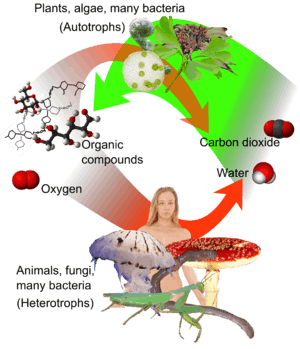
2).
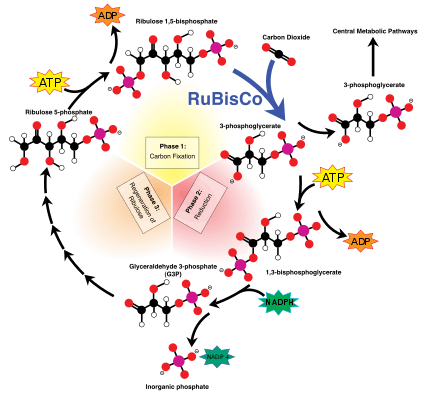
Carbon fixation is a biochemical process by which atmospheric carbon dioxide is incorporated by plants, algae and (cyanobacteria) into energy-rich organic molecules such as glucose, thus creating their own food by photosynthesis. Photosynthesis uses carbon dioxide and water to produce sugars from which other organic compounds can be constructed, and oxygen is produced as a by-product.
Ribulose-1,5-bisphosphate carboxylase oxygenase, commonly abbreviated to RuBisCO, is the enzyme involved in the first major step of carbon fixation, the production of two molecules of 3-phosphoglycerate from CO
2 and ribulose bisphosphate, as shown in the diagram at left.
RuBisCO is thought to be the single most abundant protein on Earth.[113]
Phototrophs use the products of their photosynthesis as internal food sources and as raw material for the biosynthesis of more complex organic molecules, such as polysaccharides, nucleic acids and proteins. These are used for their own growth, and also as the basis of the food chains and webs that feed other organisms, including animals such as ourselves. Some important phototrophs, the coccolithophores synthesise hard calcium carbonate scales.[114] A globally significant species of coccolithophore is Emiliania huxleyi whose calcite scales have formed the basis of many sedimentary rocks such as limestone, where what was previously atmospheric carbon can remain fixed for geological timescales.
Plants can grow as much as 50 percent faster in concentrations of 1,000 ppm CO
2 when compared with ambient conditions, though this assumes no change in climate and no limitation on other nutrients.[115] Elevated CO
2 levels cause increased growth reflected in the harvestable yield of crops, with wheat, rice and soybean all showing increases in yield of 12–14% under elevated CO
2 in FACE experiments.[116][117]
Increased atmospheric CO
2 concentrations result in fewer stomata developing on plants[118] which leads to reduced water usage and increased water-use efficiency.[119] Studies using FACE have shown that CO
2 enrichment leads to decreased concentrations of micronutrients in crop plants.[120] This may have knock-on effects on other parts of ecosystems as herbivores will need to eat more food to gain the same amount of protein.[121]
The concentration of secondary metabolites such as phenylpropanoids and flavonoids
can also be altered in plants exposed to high concentrations of CO
2.[122][123]
Plants also emit CO
2 during respiration, and so the majority of plants and algae, which use C3 photosynthesis, are only net absorbers during the day. Though a growing forest will absorb many tons of CO
2 each year, a mature forest will produce as much CO
2 from respiration and decomposition of dead specimens (e.g., fallen branches) as is used in photosynthesis in growing plants.[124] Contrary to the long-standing view that they are carbon neutral, mature forests can continue to accumulate carbon[125] and remain valuable carbon sinks, helping to maintain the carbon balance of Earth's atmosphere. Additionally, and crucially to life on earth, photosynthesis by phytoplankton consumes dissolved CO
2 in the upper ocean and thereby promotes the absorption of CO
2 from the atmosphere.[126]
Toxicity
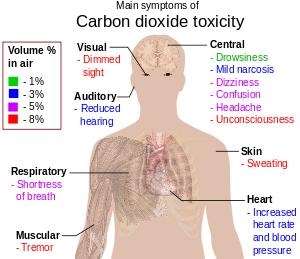
Carbon dioxide content in fresh air (averaged between sea-level and 10 kPa level, i.e., about 30 km (19 mi) altitude) varies between 0.036% (360 ppm) and 0.041% (412 ppm), depending on the location.[128]
CO
2 is an asphyxiant gas and not classified as toxic or harmful in accordance with Globally Harmonized System of Classification and Labelling of Chemicals standards of United Nations Economic Commission for Europe by using the OECD Guidelines for the Testing of Chemicals. In concentrations up to 1% (10,000 ppm), it will make some people feel drowsy and give the lungs a stuffy feeling.[127] Concentrations of 7% to 10% (70,000 to 100,000 ppm) may cause suffocation, even in the presence of sufficient oxygen, manifesting as dizziness, headache, visual and hearing dysfunction, and unconsciousness within a few minutes to an hour.[129] The physiological effects of acute carbon dioxide exposure are grouped together under the term hypercapnia, a subset of asphyxiation.
Because it is heavier than air, in locations where the gas seeps from the ground (due to sub-surface volcanic or geothermal activity) in relatively high concentrations, without the dispersing effects of wind, it can collect in sheltered/pocketed locations below average ground level, causing animals located therein to be suffocated. Carrion feeders attracted to the carcasses are then also killed. Children have been killed in the same way near the city of Goma by CO
2 emissions from the nearby volcano Mt. Nyiragongo.[130] The Swahili term for this phenomenon is 'mazuku'.
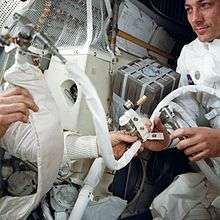
2 threatened the Apollo 13 astronauts who had to adapt cartridges from the command module to supply the carbon dioxide scrubber in the lunar module, which they used as a lifeboat.
Adaptation to increased concentrations of CO
2 occurs in humans, including modified breathing and kidney bicarbonate production, in order to balance the effects of blood acidification (acidosis). Several studies suggested that 2.0 percent inspired concentrations could be used for closed air spaces (e.g. a submarine) since the adaptation is physiological and reversible, as deterioration in performance or in normal physical activity does not happen at this level of exposure for five days.[131][132] Yet, other studies show a decrease in cognitive function even at much lower levels.[133][134] Also, with ongoing respiratory acidosis, adaptation or compensatory mechanisms will be unable to reverse such condition.
Below 1%
There are few studies of the health effects of long-term continuous CO
2 exposure on humans and animals at levels below 1%. Occupational CO
2 exposure limits have been set in the United States at 0.5% (5000 ppm) for an eight-hour period.[135] At this CO
2 concentration, International Space Station crew experienced headaches, lethargy, mental slowness, emotional irritation, and sleep disruption.[136] Studies in animals at 0.5% CO
2 have demonstrated kidney calcification and bone loss after eight weeks of exposure.[137] A study of humans exposed in 2.5 hour sessions demonstrated significant negative effects on cognitive abilities at concentrations as low as 0.1% (1000 ppm) CO
2 likely due to CO
2 induced increases in cerebral blood flow.[133] Another study observed a decline in basic activity level and information usage at 1000 ppm, when compared to 500 ppm.[134]
Ventilation
Poor ventilation is one of the main causes of excessive CO
2 concentrations in closed spaces. Carbon dioxide differential above outdoor concentrations at steady state conditions (when the occupancy and ventilation system operation are sufficiently long that CO
2 concentration has stabilized) are sometimes used to estimate ventilation rates per person. Higher CO
2 concentrations are associated with occupant health, comfort and performance degradation.[138][139] ASHRAE Standard 62.1–2007 ventilation rates may result in indoor concentrations up to 2,100 ppm above ambient outdoor conditions. Thus if the outdoor concentration is 400 ppm, indoor concentrations may reach 2,500 ppm with ventilation rates that meet this industry consensus standard. Concentrations in poorly ventilated spaces can be found even higher than this (range of 3,000 or 4,000).
Miners, who are particularly vulnerable to gas exposure due to an insufficient ventilation, referred to mixtures of carbon dioxide and nitrogen as "blackdamp," "choke damp" or "stythe." Before more effective technologies were developed, miners would frequently monitor for dangerous levels of blackdamp and other gases in mine shafts by bringing a caged canary with them as they worked. The canary is more sensitive to asphyxiant gases than humans, and as it became unconscious would stop singing and fall off its perch. The Davy lamp could also detect high levels of blackdamp (which sinks, and collects near the floor) by burning less brightly, while methane, another suffocating gas and explosion risk, would make the lamp burn more brightly.
In February 2020, three people died from suffocation at a party in Moscow when dry ice (frozen CO2) was added to a swimming pool to cool it down.[140]
Human physiology
Content
| kPa | mmHg | |
|---|---|---|
| Venous blood carbon dioxide | 5.5–6.8 | 41–51[141] |
| Alveolar pulmonary gas pressures |
4.8 | 36 |
| Arterial blood carbon dioxide | 4.7–6.0 | 35–45[141] |
The body produces approximately 2.3 pounds (1.0 kg) of carbon dioxide per day per person,[142] containing 0.63 pounds (290 g) of carbon. In humans, this carbon dioxide is carried through the venous system and is breathed out through the lungs, resulting in lower concentrations in the arteries. The carbon dioxide content of the blood is often given as the partial pressure, which is the pressure which carbon dioxide would have had if it alone occupied the volume.[143] In humans, the blood carbon dioxide contents is shown in the adjacent table:
Transport in the blood
CO
2 is carried in blood in three different ways. (The exact percentages vary depending whether it is arterial or venous blood).
- Most of it (about 70% to 80%) is converted to bicarbonate ions HCO−
3 by the enzyme carbonic anhydrase in the red blood cells, by the reaction CO
2 + H
2O → H
2CO
3 → H+
+ HCO−
3. - 5–10% is dissolved in the plasma
- 5–10% is bound to hemoglobin as carbamino compounds
Hemoglobin, the main oxygen-carrying molecule in red blood cells, carries both oxygen and carbon dioxide. However, the CO
2 bound to hemoglobin does not bind to the same site as oxygen. Instead, it combines with the N-terminal groups on the four globin chains. However, because of allosteric effects on the hemoglobin molecule, the binding of CO
2 decreases the amount of oxygen that is bound for a given partial pressure of oxygen. This is known as the Haldane Effect, and is important in the transport of carbon dioxide from the tissues to the lungs. Conversely, a rise in the partial pressure of CO
2 or a lower pH will cause offloading of oxygen from hemoglobin, which is known as the Bohr effect.
Regulation of respiration
Carbon dioxide is one of the mediators of local autoregulation of blood supply. If its concentration is high, the capillaries expand to allow a greater blood flow to that tissue.
Bicarbonate ions are crucial for regulating blood pH. A person's breathing rate influences the level of CO
2 in their blood. Breathing that is too slow or shallow causes respiratory acidosis, while breathing that is too rapid leads to hyperventilation, which can cause respiratory alkalosis.
Although the body requires oxygen for metabolism, low oxygen levels normally do not stimulate breathing. Rather, breathing is stimulated by higher carbon dioxide levels. As a result, breathing low-pressure air or a gas mixture with no oxygen at all (such as pure nitrogen) can lead to loss of consciousness without ever experiencing air hunger. This is especially perilous for high-altitude fighter pilots. It is also why flight attendants instruct passengers, in case of loss of cabin pressure, to apply the oxygen mask to themselves first before helping others; otherwise, one risks losing consciousness.
The respiratory centers try to maintain an arterial CO
2 pressure of 40 mm Hg. With intentional hyperventilation, the CO
2 content of arterial blood may be lowered to 10–20 mm Hg (the oxygen content of the blood is little affected), and the respiratory drive is diminished. This is why one can hold one's breath longer after hyperventilating than without hyperventilating. This carries the risk that unconsciousness may result before the need to breathe becomes overwhelming, which is why hyperventilation is particularly dangerous before free diving.
See also
- Arterial blood gas
- Bosch reaction
- Bottled gas – Substances which are gaseous at standard temperature and pressure and have been compressed and stored in gas cylinders
- Carbon dioxide sensor
- Carbon sequestration – Capture and long-term storage of atmospheric carbon dioxide
- Cave of Dogs – Cave near Naples, Italy
- EcoCute – as refrigerants
- Emission standards
- Indoor air quality – Air quality within and around buildings and structures
- Kaya identity – Identity regarding anthropogenic carbon dioxide emissions
- Lake Kivu – Meromictic lake in the East African Rift valley
- List of least carbon efficient power stations – Wikipedia list article
- List of countries by carbon dioxide emissions – Wikimedia list article
- Meromictic lake – Lake with layers of water that do not intermix
- pCO2 – Partial pressure of carbon dioxide, often used in reference to blood
- Gilbert Plass (early work on CO
2 and climate change) - Sabatier reaction – Methanation process of carbon dioxide with hydrogen
- NASA's Orbiting Carbon Observatory 2
- Greenhouse Gases Observing Satellite
References
- "Carbon Dioxide" (PDF). Air Products.
- Touloukian, Y.S., Liley, P.E., and Saxena, S.C. Thermophysical properties of matter - the TPRC data series. Volume 3. Thermal conductivity - nonmetallic liquids and gases. Data book. 1970.
- Schäfer, Michael; Richter, Markus; Span, Roland (2015). "Measurements of the viscosity of carbon dioxide at temperatures from (253.15 to 473.15)K with pressures up to 1.2MPa". The Journal of Chemical Thermodynamics. 89: 7–15. doi:10.1016/j.jct.2015.04.015. ISSN 0021-9614.
- "Safety Data Sheet – Carbon Dioxide Gas – version 0.03 11/11" (PDF). AirGas.com. 12 February 2018. Retrieved 4 August 2018.
- "Carbon dioxide, refrigerated liquid" (PDF). Praxair. p. 9. Archived from the original (PDF) on 29 July 2018. Retrieved 26 July 2018.
- "Carbon dioxide". Immediately Dangerous to Life and Health Concentrations (IDLH). National Institute for Occupational Safety and Health (NIOSH).
- NIOSH Pocket Guide to Chemical Hazards. "#0103". National Institute for Occupational Safety and Health (NIOSH).
- Eggleton, Tony (2013). A Short Introduction to Climate Change. Cambridge University Press. p. 52. ISBN 9781107618763.
- https://www.healthline.com/nutrition/carbonated-water-good-or-bad
- Kaufman, Donald G.; Franz, Cecilia M. (1996). Biosphere 2000: protecting our global environment. Kendall/Hunt Pub. Co. ISBN 978-0-7872-0460-0.
- "Food Factories". www.legacyproject.org. Retrieved 10 October 2011.
- Lénárd-István Csepei (2011). Kinetic studies of propane oxidation on Mo and V based mixed oxide catalysts (PDF) (PHD thesis). Technical University of Berlin.
- Amakawa, Kazuhiko; Kolen'ko, Yury V.; Villa, Alberto; Schuster, Manfred Erwin; Csepei, Lenard-Istvan; Weinberg, Gisela; Wrabetz, Sabine; Naumann d'Alnoncourt, Raoul; Girgsdies, Frank; Prati, Laura; Schloegl, Robert; Trunschke, Annette (2013). "Multifunctionality of Crystalline MoV(TeNb) M1 Oxide Catalysts in Selective Oxidation of Propane and Benzyl Alcohol". ACS Catalysis. 3 (6): 1103–1113. doi:10.1021/cs400010q.
- Naumann d’Alnoncourt, Raoul; Csepei, Lénárd-István; Hävecker, Michael; Girgsdies, Frank; Schuster, Manfred E.; Schlögl, Robert; Trunschke, Annette (2014). "The reaction network in propane oxidation over phase-pure MoVTeNb M1 oxide catalysts" (PDF). Journal of Catalysis. 311: 369–385. doi:10.1016/j.jcat.2013.12.008. hdl:11858/00-001M-0000-0014-F434-5. Archived from the original (PDF) on 15 February 2016. Retrieved 9 July 2017.
- Tsotsas, Evangelos; Mujumdar, Arun S. (2011). Modern drying technology. 3: Product quality and formulation. John Wiley & Sons. ISBN 978-3-527-31558-1.
- Mikhail, M.; Wang, B.; Jalain, R.; Cavadias, S.; Tatoulian, M.; Ognier, S.; Gálvez, M. E.; Da Costa, P. (1 April 2019). "Plasma-catalytic hybrid process for CO2 methanation: optimization of operation parameters". Reaction Kinetics, Mechanisms and Catalysis. 126 (2): 629–643. doi:10.1007/s11144-018-1508-8. ISSN 1878-5204.
- "Catalysts for climate protection". 19 August 2019.
- Voiry, Damien; Shin, Hyeon Suk; Loh, Kian Ping; Chhowalla, Manish (January 2018). "Low-dimensional catalysts for hydrogen evolution and CO2 reduction". Nature Reviews Chemistry. 2 (1): 0105. doi:10.1038/s41570-017-0105. ISSN 2397-3358.
- Gomez, Elaine; Yan, Binhang; Kattel, Shyam; Chen, Jingguang G. (10 September 2019). "Carbon dioxide reduction in tandem with light-alkane dehydrogenation". Nature Reviews Chemistry. 3 (11): 638–649. doi:10.1038/s41570-019-0128-9. ISSN 2397-3358.
- Ocean Acidification: A National Strategy to Meet the Challenges of a Changing Ocean. Washington, DC: National Academies Press. 22 April 2010. doi:10.17226/12904. ISBN 978-0-309-15359-1.
- DavidFraser Harris (September 1910). "The Pioneer in the Hygiene of Ventilation". The Lancet. 176 (4542): 906–908. doi:10.1016/S0140-6736(00)52420-9.
- Almqvist, Ebbe (2003). History of industrial gases. Springer. ISBN 978-0-306-47277-0. p. 93
- Priestley, Joseph; Hey, Wm (1772). "Observations on Different Kinds of Air". Philosophical Transactions. 62: 147–264. doi:10.1098/rstl.1772.0021.
- Davy, Humphry (1823). "On the Application of Liquids Formed by the Condensation of Gases as Mechanical Agents". Philosophical Transactions. 113: 199–205. doi:10.1098/rstl.1823.0020. JSTOR 107649.
- Thilorier, Adrien-Jean-Pierre (1835). "Solidification de l'Acide carbonique". Comptes Rendus. 1: 194–196.
- "Solidification of carbonic acid". The London and Edinburgh Philosophical Magazine. 8 (48): 446–447. 1836. doi:10.1080/14786443608648911.
- Greenwood, Norman N.; Earnshaw, Alan (1997). Chemistry of the Elements (2nd ed.). Butterworth-Heinemann. ISBN 978-0-08-037941-8.
- Atkins P. and de Paula J. Physical Chemistry (8th ed., W.H. Freeman 2006) pp. 461, 464 ISBN 0-7167-8759-8
- Per Jensen; M. Spanner; P. R. Bunker (2020). "The CO2 molecule is never linear". J Mol Struct. 1212: 128087. doi:10.1016/j.molstruc.2020.128087.
- B. Siegmann; U. Werner; H. O. Lutz; R. Mann (2002). "Complete Coulomb fragmentation of CO2 in collisions with 5.9 MeV u−1 Xe18+ and Xe43+". J Phys B Atom Mol Opt Phys. 35 (17): 3755. doi:10.1088/0953-4075/35/17/311.
- Jolly, William L., Modern Inorganic Chemistry (McGraw-Hill 1984), p. 196 ISBN 0-07-032760-2
- Li, Zhen; Mayer, Robert J.; Ofial, Armin R.; Mayr, Herbert (27 April 2020). "From Carbodiimides to Carbon Dioxide: Quantification of the Electrophilic Reactivities of Heteroallenes". Journal of the American Chemical Society. 142 (18): 8383–8402. doi:10.1021/jacs.0c01960. PMID 32338511.
- M. Aresta (Ed.) "Carbon Dioxide as a Chemical Feedstock" 2010, Wiley-VCH: Weinheim. ISBN 978-3-527-32475-0
- Finn, Colin; Schnittger, Sorcha; Yellowlees, Lesley J.; Love, Jason B. (2012). "Molecular approaches to the electrochemical reduction of carbon dioxide" (PDF). Chemical Communications. 48 (10): 1392–1399. doi:10.1039/c1cc15393e. PMID 22116300.
- "Phase change data for Carbon dioxide". National Institute of Standards and Technology. Retrieved 21 January 2008.
- Kudryavtseva I.V., Kamotskii V.I., Rykov S.V., Rykov V.A., "Calculation Carbon Dioxide Line of Phase Equilibrium", Processes and equipment for food production, Number 4(18), 2013
- Santoro, M.; Gorelli, FA; Bini, R; Ruocco, G; Scandolo, S; Crichton, WA (2006). "Amorphous silica-like carbon dioxide". Nature. 441 (7095): 857–860. Bibcode:2006Natur.441..857S. doi:10.1038/nature04879. PMID 16778885.
- Department of Energy, Department of Energy. "Supercritical CO2 Tech Team". U.S Department of Energy. U.S Department of Energy. Retrieved 26 March 2020.
- Pierantozzi, Ronald (2001). "Carbon Dioxide". Kirk-Othmer Encyclopedia of Chemical Technology. Kirk-Othmer Encyclopedia of Chemical Technology. Wiley. doi:10.1002/0471238961.0301180216090518.a01.pub2. ISBN 978-0-471-23896-6.
- Strassburger, Julius (1969). Blast Furnace Theory and Practice. New York: American Institute of Mining, Metallurgical, and Petroleum Engineers. ISBN 978-0-677-10420-1.
- Susan Topham "Carbon Dioxide" in Ullmann's Encyclopedia of Industrial Chemistry, 2005, Wiley-VCH, Weinheim. doi:10.1002/14356007.a05_165
- "CO2 shortage: Food industry calls for government action". BBC. 21 June 2018.
- "Collecting and using biogas from landfills". U.S. Energy Information Administration. 11 January 2017. Retrieved 22 November 2015.
- "Facts About Landfill Gas" (PDF). U.S. Environmental Protection Agency. January 2000.
- "IPCC Special Report on Carbon dioxide Capture and Storage" (PDF). Archived from the original (PDF) on 24 September 2015. Retrieved 4 September 2015.
- R.T. Morrison and R.N. Boyd (1983). Organic Chemistry (4th ed.). Allyn and Bacon. pp. 976–977. ISBN 978-0-205-05838-9.
- Badwal, Sukhvinder P. S.; Giddey, Sarbjit S.; Munnings, Christopher; Bhatt, Anand I.; Hollenkamp, Anthony F. (24 September 2014). "Emerging electrochemical energy conversion and storage technologies (open access)". Frontiers in Chemistry. 2: 79. Bibcode:2014FrCh....2...79B. doi:10.3389/fchem.2014.00079. PMC 4174133. PMID 25309898.
- UK Food Standards Agency: "Current EU approved additives and their E Numbers". Retrieved 27 October 2011.
- US Food and Drug Administration: "Food Additive Status List". Retrieved 13 June 2015.
- Australia New Zealand Food Standards Code"Standard 1.2.4 – Labelling of ingredients". Retrieved 27 October 2011.
- Futurific Leading Indicators Magazine Volume 1. CRAES LLC. ISBN 978-0-9847670-1-4.
- Vijay, G. Padma (25 September 2015). Indian Breads: A Comprehensive Guide to Traditional and Innovative Indian Breads. Westland. ISBN 978-93-85724-46-6.
- "Scientists Discover Protein Receptor For Carbonation Taste". ScienceDaily. 16 October 2009. Retrieved 29 March 2020.
- Andy Coghlan (3 February 2018). "A more humane way of slaughtering chickens might get EU approval". New Scientist.
- "What is CO2 stunning?". RSPCA. Archived from the original on 9 April 2014.
- Archie Campbell (10 March 2018). "Humane execution and the fear of the tumbril". New Scientist.
- Nordestgaard, B.G.; Rostgaard, J. (1985). "Critical‐point drying versus freeze drying for scanning electron microscopy: a quantitative and qualitative study on isolated hepatocytes". Journal of Microscopy. 137 (2): 189–207. doi:10.1111/j.1365-2818.1985.tb02577.x. PMID 3989858.
- National Fire Protection Association Code 12
- Carbon Dioxide as a Fire Suppressant: Examining the Risks, US EPA. 2000.
- Whiting, David; Roll, Michael; Vickerman, Larry (August 2010). "Plant Growth Factors: Photosynthesis, Respiration, and Transpiration". CMG GardenNotes. Colorado Master Gardener Program. Archived from the original on 2 September 2014. Retrieved 10 October 2011.
- Waggoner, Paul E. (February 1994). "Carbon dioxide". How Much Land Can Ten Billion People Spare for Nature?. Retrieved 10 October 2011.
- Stafford, Ned (7 February 2007). "Future crops: The other greenhouse effect". Nature. 448 (7153): 526–528. Bibcode:2007Natur.448..526S. doi:10.1038/448526a. PMID 17671477.
- "Appendix A: CO
2 for use in enhanced oil recovery (EOR)". Accelerating the uptake of CCS: industrial use of captured carbon dioxide. Global CCS Institute. 20 December 2011. Retrieved 2 January 2017. - Austell, J Michael (2005). "CO
2 for Enhanced Oil Recovery Needs – Enhanced Fiscal Incentives". Exploration & Production: The Oil & Gas Review. Archived from the original on 7 February 2012. Retrieved 28 September 2007. - "Enhanced coal bed methane recovery". ETH Zurich. 31 August 2006. Archived from the original on 6 July 2011.
- Clayton, Mark (11 January 2006). "Algae – like a breath mint for smokestacks". The Christian Science Monitor. Retrieved 11 October 2007.
- Atsum, Shota; Higashide, Wendy; Liauo, James C. (November 2009). "Direct photosynthetic recycling of carbon dioxide to isobutyraldehyde". Nature Biotechnology. 27 (12): 1177–1180. doi:10.1038/nbt.1586. PMID 19915552.
- "The Coca-Cola Company Announces Adoption of HFC-Free Insulation in Refrigeration Units to Combat Global Warming". The Coca-Cola Company. 5 June 2006. Retrieved 11 October 2007.
- "Modine reinforces its CO
2 research efforts". R744.com. 28 June 2007. Archived from the original on 10 February 2008. - TCE, the Chemical Engineer. Institution of Chemical Engineers. 1990.
- "2013 AVMA Guidelines for the Euthanasia of Animals" (PDF). Retrieved 14 January 2014.
- National Oceanic & Atmospheric Administration (NOAA) – Earth System Research Laboratory (ESRL), Trends in Carbon Dioxide: Globally averaged marine surface monthly mean data Values given are dry air mole fractions expressed in parts per million (ppm). For an ideal gas mixture this is equivalent to parts per million by volume (ppmv).
- Pashley, Alex (10 March 2016). "CO2 levels make largest recorded annual leap, Noaa data shows". The Guardian. Retrieved 14 March 2016.
- "Record annual increase of carbon dioxide observed at Mauna Loa for 2015". NOAA. 9 March 2016. Retrieved 14 March 2016.
- George, K.; Ziska, L.H.; Bunce, J.A.; Quebedeaux, B. (2007). "Elevated atmospheric CO
2 concentration and temperature across an urban–rural transect". Atmospheric Environment. 41 (35): 7654–7665. Bibcode:2007AtmEn..41.7654G. doi:10.1016/j.atmosenv.2007.08.018. - Tans, Pieter (6 May 2019) "Annual CO
2 mole fraction increase (ppm)" for 1959–2018. National Oceanic and Atmospheric Administration Earth System Research Laboratory, Global Monitoring Division (additional details.) - Li, Anthony HF. "Hopes of Limiting Global Warming? China and the Paris Agreement on Climate Change." China Perspectives 1 (2016): 49.
- "After two large annual gains, rate of atmospheric CO
2 increase returns to average". NOAA News Online, Story 2412. 31 March 2005. - "Global Warming Frequently Asked Questions". Climate.gov. NOAA. Archived from the original on 11 January 2017.
- Gerlach, T.M. (4 June 1991). "Present-day CO
2 emissions from volcanoes". Eos, Transactions, American Geophysical Union. 72 (23): 249, 254–255. Bibcode:1991EOSTr..72..249.. doi:10.1029/90EO10192. - Buis, Alan; Ramsayer, Kate; Rasmussen, Carol (12 November 2015). "A breathing planet, off balance". NASA. Retrieved 13 November 2015.
- Staff (12 November 2015). "Audio (66:01) – NASA News Conference – Carbon & Climate Telecon". NASA. Retrieved 12 November 2015.
- St. Fleur, Nicholas (10 November 2015). "Atmospheric Greenhouse Gas Levels Hit Record, Report Says". The New York Times. Retrieved 11 November 2015.
- Ritter, Karl (9 November 2015). "UK: In 1st, global temps average could be 1 degree C higher". Associated Press. Retrieved 11 November 2015.
- Atkins, Peter; de Paula, Julio (2006). Atkins' Physical Chemistry (8th ed.). W.H. Freeman. p. 462. ISBN 978-0-7167-8759-4.
- UCAR (2012). "Carbon Dioxide Absorbs and Re-emits Infrared Radiation". UCAR Center for Science Education. Retrieved 9 September 2017.
- Genthon, G.; Barnola, J.M.; Raynaud, D.; Lorius, C.; Jouzel, J.; Barkov, N.I.; Korotkevich, Y.S.; Kotlyakov, V.M. (1987). "Vostok ice core: climatic response to CO
2 and orbital forcing changes over the last climatic cycle". Nature. 329 (6138): 414–418. Bibcode:1987Natur.329..414G. doi:10.1038/329414a0. - "Climate and CO
2 in the Atmosphere". Retrieved 10 October 2007. - Berner, Robert A.; Kothavala, Zavareth (2001). "GEOCARB III: A revised model of atmospheric CO
2 over Phanerozoic Time" (PDF). American Journal of Science. 301 (2): 182–204. Bibcode:2001AmJS..301..182B. CiteSeerX 10.1.1.393.582. doi:10.2475/ajs.301.2.182. Retrieved 15 February 2008. - van Gardingen, P.R.; Grace, J.; Jeffree, C.E.; Byari, S.H.; Miglietta, F.; Raschi, A.; Bettarini, I. (1997). "Long-term effects of enhanced CO
2 concentrations on leaf gas exchange: research opportunities using CO
2 springs". In Raschi, A.; Miglietta, F.; Tognetti, R.; van Gardingen, P.R. (eds.). Plant responses to elevated CO
2: Evidence from natural springs. Cambridge: Cambridge University Press. pp. 69–86. ISBN 978-0-521-58203-2. - Martini, M. (1997). "CO
2 emissions in volcanic areas: case histories and hazards". In Raschi, A.; Miglietta, F.; Tognetti, R.; van Gardingen, P.R. (eds.). Plant responses to elevated CO
2: Evidence from natural springs. Cambridge: Cambridge University Press. pp. 69–86. ISBN 978-0-521-58203-2. - Doney, Scott C.; Levine, Naomi M. (29 November 2006). "How Long Can the Ocean Slow Global Warming?". Oceanus. Retrieved 21 November 2007.
- Nienhuis, S.; Palmer, A.; Harley, C. (2010). "Elevated CO
2 affects shell dissolution rate but not calcification rate in a marine snail". Proceedings of the Royal Society B: Biological Sciences. 277 (1693): 2553–2558. doi:10.1098/rspb.2010.0206. PMC 2894921. PMID 20392726. - Gattuso, J.-P.; Frankignoulle, M.; Bourge, I.; Romaine, S. & Buddemeier, R.W. (1998). "Effect of calcium carbonate saturation of seawater on coral calcification". Global and Planetary Change. 18 (1–2): 37–46. Bibcode:1998GPC....18...37G. doi:10.1016/S0921-8181(98)00035-6.
- Gattuso, J.-P.; Allemand, D.; Frankignoulle, M (1999). "Photosynthesis and calcification at cellular, organismal and community levels in coral reefs: a review on interactions and control by carbonate chemistry". American Zoologist. 39: 160–183. doi:10.1093/icb/39.1.160.
-
Langdon, C; Atkinson, M. J. (2005). "Effect of elevated pCO
2 on photosynthesis and calcification of corals and interactions with seasonal change in temperature/irradiance and nutrient enrichment". Journal of Geophysical Research. 110 (C09S07): C09S07. Bibcode:2005JGRC..110.9S07L. doi:10.1029/2004JC002576. -
Riebesell, Ulf; Zondervan, Ingrid; Rost, Björn; Tortell, Philippe D.; Zeebe, Richard E. & François M.M. Morel (2000). "Reduced calcification of marine plankton in response to increased atmospheric CO
2". Nature. 407 (6802): 364–367. Bibcode:2000Natur.407..364R. doi:10.1038/35030078. PMID 11014189. -
Zondervan, I.; Zeebe, R.E.; Rost, B.; Rieblesell, U. (2001). "Decreasing marine biogenic calcification: a negative feedback on rising atmospheric CO
2" (PDF). Global Biogeochemical Cycles. 15 (2): 507–516. Bibcode:2001GBioC..15..507Z. doi:10.1029/2000GB001321. - Zondervan, I.; Rost, B.; Rieblesell, U. (2002). "Effect of CO
2 concentration on the PIC/POC ratio in the coccolithophore Emiliania huxleyi grown under light limiting conditions and different day lengths" (PDF). Journal of Experimental Marine Biology and Ecology. 272 (1): 55–70. doi:10.1016/S0022-0981(02)00037-0. - Delille, B.; Harlay, J.; Zondervan, I.; Jacquet, S.; Chou, L.; Wollast, R.; Bellerby, R.G.J.; Frankignoulle, M.; Borges, A.V.; Riebesell, U.; Gattuso, J.-P. (2005). "Response of primary production and calcification to changes of pCO
2 during experimental blooms of the coccolithophorid Emiliania huxleyi". Global Biogeochemical Cycles. 19 (2): GB2023. Bibcode:2005GBioC..19.2023D. doi:10.1029/2004GB002318. - Kuffner, I.B.; Andersson, A.J.; Jokiel, P.L.; Rodgers, K.S.; Mackenzie, F.T. (2007). "Decreased abundance of crustose coralline algae due to ocean acidification". Nature Geoscience. 1 (2): 114–117. Bibcode:2008NatGe...1..114K. doi:10.1038/ngeo100.
- Phillips, Graham; Chris Branagan (13 September 2007). "Ocean Acidification – The BIG global warming story". ABC TV Science: Catalyst. Australian Broadcasting Corporation. Retrieved 18 September 2007.
-
Gazeau, F.; Quiblier, C.; Jansen, J.M.; Gattuso, J.-P.; Middelburg, J.J. & Heip, C.H.R. (2007). "Impact of elevated CO
2 on shellfish calcification". Geophysical Research Letters. 34 (7): L07603. Bibcode:2007GeoRL..34.7603G. CiteSeerX 10.1.1.326.1630. doi:10.1029/2006GL028554. hdl:20.500.11755/a8941c6a-6d0b-43d5-ba0d-157a7aa05668. - Comeau, C.; Gorsky, G.; Jeffree, R.; Teyssié, J.-L.; Gattuso, J.-P. (2009). "Impact of ocean acidification on a key Arctic pelagic mollusc (Limacina helicina)". Biogeosciences. 6 (9): 1877–1882. Bibcode:2009BGeo....6.1877C. doi:10.5194/bg-6-1877-2009.
- Duana, Zhenhao; Rui Sun (2003). "An improved model calculating CO
2 solubility in pure water and aqueous NaCl solutions from 273 to 533 K and from 0 to 2000 bar". Chemical Geology. 193 (3–4): 257–271. Bibcode:2003ChGeo.193..257D. doi:10.1016/S0009-2541(02)00263-2. - Cai, W.-J.; Chen, L.; Chen, B.; Gao, Z.; et al. (2010). "Decrease in the CO2 Uptake Capacity in an Ice-Free Arctic Ocean Basin". Science. 329 (5991): 556–559. Bibcode:2010Sci...329..556C. doi:10.1126/science.1189338. PMID 20651119. S2CID 206526452.
- Garrison, Tom (2004). Oceanography: An Invitation to Marine Science. Thomson Brooks. p. 125. ISBN 978-0-534-40887-9.
- Ries, J.B.; Cohen, A.L.; McCorkle, D.C. (2009). "Marine calcifiers exhibit mixed responses to CO
2-induced ocean acidification". Geology. 37 (12): 1131–1134. Bibcode:2009Geo....37.1131R. doi:10.1130/G30210A.1. - Climate Change 2007: Synthesis Report, IPCC
- "PMEL Ocean Acidification Home Page". Pmel.noaa.gov. Retrieved 14 January 2014.
- Lupton, J.; Lilley, M.; Butterfield, D.; Evans, L.; Embley, R.; Olson, E.; Proskurowski, G.; Resing, J.; Roe, K.; Greene, R.; Lebon, G. (2004). "Liquid Carbon Dioxide Venting at the Champagne Hydrothermal Site, NW Eifuku Volcano, Mariana Arc". American Geophysical Union. Fall. Meeting (abstract #V43F–08): V43F–08. Bibcode:2004AGUFM.V43F..08L.
- Fumio Inagaki (2006). "Microbial community in a sediment-hosted CO2 lake of the southern Okinawa Trough hydrothermal system". PNAS. 103 (38): 14164–14169. Bibcode:2006PNAS..10314164I. doi:10.1073/pnas.0606083103. PMC 1599929. PMID 16959888. Videos can be downloaded at Supporting Information.
- Dhingra A, Portis AR, Daniell H (2004). "Enhanced translation of a chloroplast-expressed RbcS gene restores small subunit levels and photosynthesis in nuclear RbcS antisense plants". Proc. Natl. Acad. Sci. U.S.A. 101 (16): 6315–6320. Bibcode:2004PNAS..101.6315D. doi:10.1073/pnas.0400981101. PMC 395966. PMID 15067115.
(Rubisco) is the most prevalent enzyme on this planet, accounting for 30–50% of total soluble protein in the chloroplast;
- G., Falkowski, Paul; H., Knoll, Andrew; (2006.01.), Symposium (1 January 2007). Evolution of primary producers in the sea. Elsevier, Academic Press. ISBN 978-0-12-370518-1. OCLC 845654016.CS1 maint: numeric names: authors list (link)
- Blom, T.J.; W.A. Straver; F.J. Ingratta; Shalin Khosla; Wayne Brown (December 2002). "Carbon Dioxide In Greenhouses". Retrieved 12 June 2007.
- Ainsworth, Elizabeth A. (2008). "Rice production in a changing climate: a meta-analysis of responses to elevated carbon dioxide and elevated ozone concentration" (PDF). Global Change Biology. 14 (7): 1642–1650. Bibcode:2008GCBio..14.1642A. doi:10.1111/j.1365-2486.2008.01594.x. Archived from the original (PDF) on 19 July 2011.
- Long, S.P.; Ainsworth, E.A.; Leakey, A.D.; Nösberger, J.; Ort, D.R. (2006). "Food for thought: lower-than-expected crop yield stimulation with rising CO
2 concentrations" (PDF). Science. 312 (5782): 1918–1921. Bibcode:2006Sci...312.1918L. CiteSeerX 10.1.1.542.5784. doi:10.1126/science.1114722. PMID 16809532. - F. Woodward; C. Kelly (1995). "The influence of CO
2 concentration on stomatal density". New Phytologist. 131 (3): 311–327. doi:10.1111/j.1469-8137.1995.tb03067.x. - Drake, Bert G.; Gonzalez-Meler, Miquel A.; Long, Steve P. (1997). "More efficient plants: A consequence of rising atmospheric CO
2?". Annual Review of Plant Physiology and Plant Molecular Biology. 48 (1): 609–639. doi:10.1146/annurev.arplant.48.1.609. PMID 15012276. S2CID 33415877. - Loladze, I (2002). "Rising atmospheric CO
2 and human nutrition: toward globally imbalanced plant stoichiometry?". Trends in Ecology & Evolution. 17 (10): 457–461. doi:10.1016/S0169-5347(02)02587-9. - Carlos E. Coviella; John T. Trumble (1999). "Effects of Elevated Atmospheric Carbon Dioxide on Insect-Plant Interactions". Conservation Biology. 13 (4): 700–712. doi:10.1046/j.1523-1739.1999.98267.x. JSTOR 2641685. S2CID 52262618.
- Davey, M.P.; Harmens, H.; Ashenden, T.W.; Edwards, R.; Baxter, R. (2007). "Species-specific effects of elevated CO
2 on resource allocation in Plantago maritima and Armeria maritima". Biochemical Systematics and Ecology. 35 (3): 121–129. doi:10.1016/j.bse.2006.09.004. - Davey, M.; Bryant, D.N.; Cummins, I.; Ashenden, T.W.; Gates, P.; Baxter, R.; Edwards, R. (2004). "Effects of elevated CO
2 on the vasculature and phenolic secondary metabolism of Plantago maritima". Phytochemistry. 65 (15): 2197–2204. doi:10.1016/j.phytochem.2004.06.016. PMID 15587703. - "Global Environment Division Greenhouse Gas Assessment Handbook – A Practical Guidance Document for the Assessment of Project-level Greenhouse Gas Emissions". World Bank. Archived from the original on 3 June 2016. Retrieved 10 November 2007.
- Luyssaert, Sebastiaan; Schulze, E.-Detlef; Börner, Annett; Knohl, Alexander; Hessenmöller, Dominik; Law, Beverly E.; Ciais, Philippe; Grace, John (2008). "Old-growth forests as global carbon sinks". Nature. 455 (7210): 213–215. Bibcode:2008Natur.455..213L. doi:10.1038/nature07276. PMID 18784722.
- Falkowski P, Scholes RJ, Boyle E, Canadell J, Canfield D, Elser J, Gruber N, Hibbard K, Högberg P, Linder S, Mackenzie FT, Moore B 3rd, Pedersen T, Rosenthal Y, Seitzinger S, Smetacek V, Steffen W (2000). "The global carbon cycle: a test of our knowledge of earth as a system". Science. 290 (5490): 291–296. Bibcode:2000Sci...290..291F. doi:10.1126/science.290.5490.291. PMID 11030643. S2CID 1779934.
- Friedman, Daniel. Toxicity of Carbon Dioxide Gas Exposure, CO
2 Poisoning Symptoms, Carbon Dioxide Exposure Limits, and Links to Toxic Gas Testing Procedures. InspectAPedia - "CarbonTracker CT2011_oi (Graphical map of CO
2)". esrl.noaa.gov. - "Carbon Dioxide as a Fire Suppressant: Examining the Risks". U.S. Environmental Protection Agency. Archived from the original on 2 October 2015.
- Volcano Under the City. PBS.org (1 November 2005).
- Glatte Jr H.A.; Motsay G.J.; Welch B.E. (1967). "Carbon Dioxide Tolerance Studies". Brooks AFB, TX School of Aerospace Medicine Technical Report. SAM-TR-67-77. Archived from the original on 9 May 2008. Retrieved 2 May 2008.
- Lambertsen, C.J. (1971). "Carbon Dioxide Tolerance and Toxicity". Environmental Biomedical Stress Data Center, Institute for Environmental Medicine, University of Pennsylvania Medical Center. IFEM. Report No. 2-71. Archived from the original on 24 July 2011. Retrieved 2 May 2008.
- Satish U.; Mendell M.J.; Shekhar K.; Hotchi T.; Sullivan D.; Streufert S.; Fisk W.J. (2012). "Is CO
2 an Indoor Pollutant? Direct Effects of Low-to-Moderate CO
2 Concentrations on Human Decision-Making Performance" (PDF). Environmental Health Perspectives. 120 (12): 1671–1677. doi:10.1289/ehp.1104789. PMC 3548274. PMID 23008272. Archived from the original (PDF) on 5 March 2016. Retrieved 11 December 2014. - Joseph G. Allen; Piers MacNaughton; Usha Satish; Suresh Santanam; Jose Vallarino; John D. Spengler (2016). "Associations of Cognitive Function Scores with Carbon Dioxide, Ventilation, and Volatile Organic Compound Exposures in Office Workers: A Controlled Exposure Study of Green and Conventional Office Environments". Environmental Health Perspectives. 124 (6): 805–812. doi:10.1289/ehp.1510037. PMC 4892924. PMID 26502459.
- "Exposure Limits for Carbon Dioxide Gas – CO
2 Limits". InspectAPedia.com. - Law J.; Watkins S.; Alexander, D. (2010). "In-Flight Carbon Dioxide Exposures and Related Symptoms: Associations, Susceptibility and Operational Implications" (PDF). NASA Technical Report. TP–2010–216126. Archived from the original (PDF) on 27 June 2011. Retrieved 26 August 2014.
- Schaefer, K.E. (1979). "Effect of Prolonged Exposure to 0.5% CO
2 on Kidney Calcification and Ultrastructure of Lungs". Undersea Biomed Res. S6: 155–161. PMID 505623. Retrieved 19 October 2014. - Allen Joseph G.; MacNaughton Piers; Satish Usha; Santanam Suresh; Vallarino Jose; Spengler John D. (1 June 2016). "Associations of Cognitive Function Scores with Carbon Dioxide, Ventilation, and Volatile Organic Compound Exposures in Office Workers: A Controlled Exposure Study of Green and Conventional Office Environments". Environmental Health Perspectives. 124 (6): 805–812. doi:10.1289/ehp.1510037. PMC 4892924. PMID 26502459.
- Romm, Joe (26 October 2015). "Exclusive: Elevated CO2 Levels Directly Affect Human Cognition, New Harvard Study Shows". ThinkProgress. Retrieved 14 October 2019.
- https://www.bbc.co.uk/news/world-europe-51680049
- "ABG (Arterial Blood Gas)". Brookside Associates. Retrieved 2 January 2017.
- "How much carbon dioxide do humans contribute through breathing?". Archived from the original on 2 February 2011. Retrieved 30 April 2009.
- Charles Henrickson (2005). Chemistry. Cliffs Notes. ISBN 978-0-7645-7419-1.
Further reading
- Seppänen, O.A.; Fisk, W.J.; Mendell, M.J. (December 1999). "Association of Ventilation Rates and CO
2 Concentrations with Health and Other Responses in Commercial and Institutional Buildings" (PDF). Indoor Air. 9 (4): 226–252. doi:10.1111/j.1600-0668.1999.00003.x. PMID 10649857. Archived from the original (PDF) on 27 December 2016. - Shendell, D.G.; Prill, R.; Fisk, W.J.; Apte, M.G.; Blake, D.; Faulkner, D. (October 2004). "Associations between classroom CO
2 concentrations and student attendance in Washington and Idaho" (PDF). Indoor Air. 14 (5): 333–341. doi:10.1111/j.1600-0668.2004.00251.x. hdl:2376/5954. PMID 15330793. Archived from the original (PDF) on 27 December 2016. - Soentgen, Jens (February 2014). "Hot air: The science and politics of CO
2". Global Environment. 7 (1): 134–171. doi:10.3197/197337314X13927191904925. - Good plant design and operation for onshore carbon capture installations and onshore pipelines: a recommended practice guidance document. Global CCS Institute. Energy Institute and Global Carbon Capture and Storage Institute. 1 September 2010. Archived from the original on 7 November 2018. Retrieved 2 January 2018.
This new title is an essential guide for engineers, managers, procurement specialists and designers working on global carbon capture and storage projects.
External links
| Wikimedia Commons has media related to Carbon dioxide. |
| Library resources about Carbon dioxide |
- International Chemical Safety Card 0021
- by Amerigas.
- CDC – NIOSH Pocket Guide to Chemical Hazards – Carbon Dioxide
- CO
2 Carbon Dioxide Properties, Uses, Applications - Dry Ice information
- Trends in Atmospheric Carbon Dioxide (NOAA)
- "A War Gas That Saves Lives". Popular Science, June 1942, pp. 53–57.
- Reactions, Thermochemistry, Uses, and Function of Carbon Dioxide
- Carbon Dioxide – Part One and Carbon Dioxide – Part Two at The Periodic Table of Videos (University of Nottingham)

